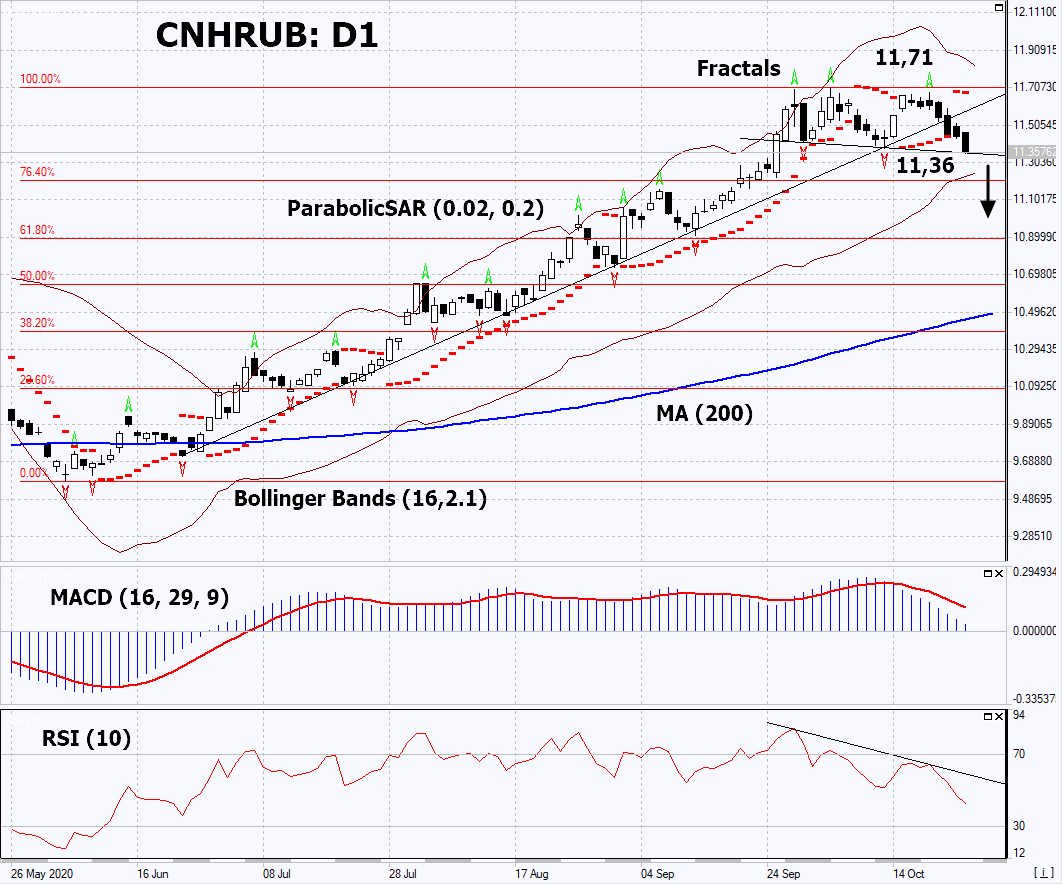- Analítica
- Análise Técnica
Yuan vs. Rublo Análise técnica - Yuan vs. Rublo Negociação: 2020-10-27
Yuan vs. Rublo Resumo da Análise Técnica
abaixo de 11,36
Sell Stop
acima de 11,71
Stop Loss
| Indicador | Sinal |
| RSI | Neutro |
| MACD | Vender |
| MA(200) | Neutro |
| Fractals | Vender |
| Parabolic SAR | Vender |
| Bollinger Bands | Neutro |
Yuan vs. Rublo Análise gráfica
Yuan vs. Rublo Análise Técnica
On the daily timeframe, CNHRUB: D1 broke down the uptrend support line and is trying to correct downward from the maximum since February 2016. A number of technical analysis indicators generated signals for further decline. We do not rule out a bearish movement if CNHRUB falls below its latest minimum: 11.35. This level can be used as an entry point. We can place a stop loss above the maximum since February 2016, the last high fractal and the Parabolic signal: 11.71. After opening a pending order, we move the stop loss to the next fractal maximum following the Bollinger and Parabolic signals. Thus, we change the potential profit/loss ratio in our favor. After the transaction, the most risk-averse traders can switch to the 4-hour chart and set a stop loss, moving it in the direction of the bias. If the price meets the stop loss (11.71) without activating the order (11.35), it is recommended to delete the order: some internal changes in the market have not taken been into account.
Análise Fundamental de PCI - Yuan vs. Rublo
In this review, we propose to consider the "&CNHRUB" Personal Composite Instrument (PCI). It reflects the price dynamics of the Chinese yuan against the Russian ruble. Will the CNHRUB quotes continue to decrease?
The downward movement means the strengthening of the ruble and the weakening of the yuan. The Chinese currency was slightly lower amid the data on GDP growth for the 3rd quarter by 4.9% qoq, though it was expected to amount to 5.2%. Russian's current yield on 10-year government bonds is 6.2% (in rubles). In China, it is lower, at 3.2% (in yuan). Perhaps the dynamics of this PCI may depend on strengthening or softening of US sanctions against Russia or China after the US presidential election. In the meantime, Chinese authorities have expressed concern about the renminbi’s excessive rise to a 27-month maximum against the greenback. In theory, People’s Bank of China can take any steps to ease the monetary policy. The Bank of Russia, on the contrary, strives to support the ruble exchange rate. Since early 2020, it has already collapsed by almost a quarter amid falling world oil prices due to the coronavirus pandemic.
Explore nossas
condições de trading
- Spreads a partir de0.0 pip
- 30,000+ Ferramentas de Trading
- Nível de Stop Out - Apenas 10%
Ready to Trade ?
Abrir Conta Nota de rodapé:
Esta visão geral é apenas para fins informativos e educacionais, e é publicada de forma gratuita. Todos os dados contidos neste documento são obtidos de fontes públicas que são consideradas mais ou menos confiáveis. Ao mesmo tempo, não há garantias de que as informações são completas e precisas. No futuro, as visões separadas não são atualizadas. Todas as informações em cada visão geral, incluindo opiniões, índices, gráficos etc., são apresentadas apenas para fins informativos e não são aconselhamentos financeiros ou recomendações. Todo o texto e qualquer parte dele, assim como os gráficos não podem ser considerados como uma oferta para realizar quaisquer transações com qualquer ativo. A empresa IFC Markets e seus funcionários sob nenhumas circunstâncias não são responsáveis por quaisquer acções, realizados por uma pessoa durante ou depois de ler a visão geral.

